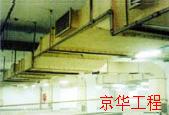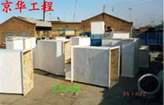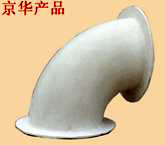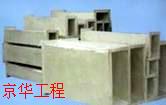 | performance Introduction | Modified, non-combustible inorganic fiberglass ventilation ducts, namely glass fiber magnesium oxychloride cement ventilation ducts, are made of magnesite inorganic composite materials (inorganic materials, cementitious materials, hydrophobic materials) as the cementing material, and glass fiber cloth as the reinforcing material. Using toughening agents, reinforcing agents and water-repellent agents, and through strict preparation procedures, processing techniques and maintenance processes, a hydration product/hardened body of crystalline steel framework and pore structure is formed. It has the advantages of light weight and high strength, corrosion resistance and aging resistance, non-toxic and non-pollution, vibration reduction and noise reduction, thermal insulation, heat resistance and non-flammability, no deformation, no cracks, no moisture absorption, no halogen return, good volume stability, etc., and long lasting. This solves the problems that organic fiberglass air ducts are easy to burn, iron air ducts are easy to corrode, have high noise, and have short service life. Moreover, the price of this product is lower than the price of organic fiberglass air duct. It is the most ideal equipment to be matched with central air conditioning. Therefore, its application in various fields of the national economy has considerable development potential and market competitiveness, and its market share is gradually expanding. It is an ideal product for indoor ventilation of large buildings at present and in the future. |  | product type | Magnesite inorganic composite materials have a greater degree of freedom in design, are not limited by the size and shape of the product, and the molding process is convenient. Therefore, our factory uses this material to produce a wide range of products, such as: various roof tiles, drainage sewage pipes, veneer panels, ceiling panels, sanitary ware, purification tanks, mobile homes, kiosks, partitions for the construction and decoration industry. Wall panels, lines, line panels, line angles, reliefs, statues, dados, spherical water tanks, etc. Used for vehicle and boat shells, packaging boxes, containers, covers, bumpers, air conditioning, air conditioning and ventilation and exhaust ducts in the transportation industry. Used in pipes, floors, water tanks, cable trays, electrical control boxes, insulated wall light poles, and tape conveyor rain covers in the petrochemical and electric power industry. Due to the stable chemical properties of this product, it can be used for sawing, planing, drilling and punching in mechanical processing; veneer, spraying, flocking and electroplating in decorative processing; pearlescent, electro-optical, reflective and various colors in coloring processing. |  | pipeline type | From the structure of the air duct: there are three types: integral type, combined type, and assembled type; from the function of the air duct: there are three types: air-conditioning type, air supply type, and exhaust (smoke) type; from the perspective of insulation performance: there are single-wall type , two types: sandwich type; according to the installation requirements: there are two types: concealed type and exposed type. It also has convenient transportation, low construction cost, no need for maintenance, and a service life of more than fifty years. |  | protrude advantage | The toughness and water resistance of this product are superior to other similar products. The outstanding shortcoming of the non-combustible inorganic fiberglass ventilation ducts currently on the market is that they are highly brittle. You can hear a squeaking sound when pressing the large surface of the product with your hand, which means that a large number of cracks have occurred on the inner and outer surfaces of the product. If you tap the product, you can hear a crisp sound, which proves that the product is brittle. In this way, during product transportation and in some unpredictable situations, it is inevitable to be impacted and extruded, which can easily produce a large number of hairline cracks on the internal and external surfaces, causing water to penetrate into these cracks, thereby reducing the service life of the air duct. In order to eliminate the above disadvantages, our factory added toughening agents and reinforcing agents in product production, which significantly improved the toughness of the product and eliminated the shortcomings that affected the service life due to the brittleness of the product. Based on years of experience in researching and producing magnesite products, we have added a patented water-repellent agent to the product to enhance its water resistance, thus ensuring long-term use of the product. The softening coefficient of our products after being immersed in water for half a year is still greater than 1, which means they have better water resistance. |  | application scope | It is widely used in ventilation and air conditioning projects in metallurgy, mining, textiles, tobacco, military industry, hotels, shopping malls, theaters, civil air defense projects, underground parking lots and high-rise buildings. It can also be used to make exhaust chimneys for flue gas and poisonous gases in the chemical industry and other industries, as well as water droplets for storage tank projects of various oils and chemical liquids. | FRP fiberglass ventilation ducts Installation methods and precautions | 1. The air duct connection should be kept vertical to avoid damaging the flange when tightening the screws. 2. The flange interface gasket should be made of rubber material that does not leak air, does not produce dust, has good elasticity and has a certain strength. The interface sealing gasket is a 5mm rubber gasket. 3. When hanging the air duct, angle iron or flat iron should be used as the bracket, and gaskets must be placed on the edges. 4. Products must not be thrown or stacked during handling and transportation. 5. When storing, keep the bottom surface flat and do not overlap the product to prevent deformation. | | FRP ventilation duct ordering instructions | 1. In order to facilitate transportation and reduce costs, air ducts can be divided into assembled types or made on site. 2. For special sizes, users need to provide simple production size drawings. 3. Our factory will handle the transportation on our behalf, and we will also provide short-distance truck transportation, and the freight will be borne by the user. 4. Our factory can undertake installation business and technical guidance. |
|
|







 冀公网安备13112202000235号
冀公网安备13112202000235号